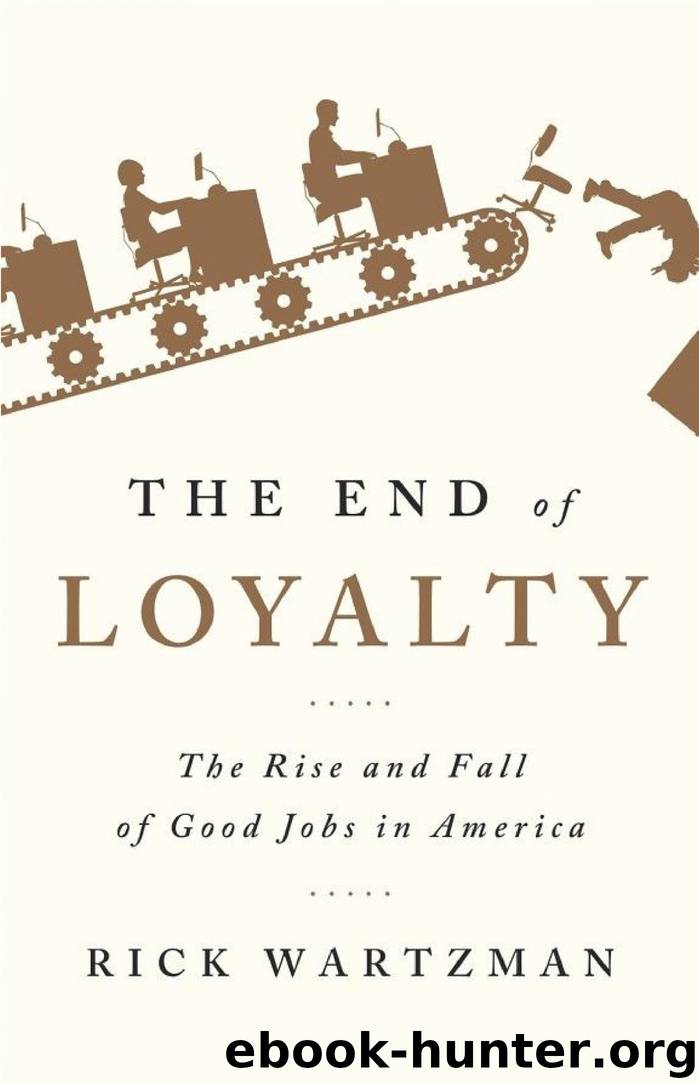The End of Loyalty: The Rise and Fall of Good Jobs in America by Rick Wartzman

Author:Rick Wartzman
Language: eng
Format: epub
Tags: Non-Fiction, Labor & Unions, Careers & Jobs, United States, History, Business & Economics
Publisher: PublicAffairs
Published: 2017-05-30T04:00:00+00:00
Officially, the one recession to sting America during the 1990s didn’t last too long, having ended in March 1991, just eight months after it had begun. But the economic expansion to follow was different than any upturn that had come before it, at least since the end of World War II.
“Even though business profits are up, output is growing, and the economy is recovering,” Michael Mandel, the chief economist at BusinessWeek, said in 1993, “help-wanted ads are still scarce, and private job growth is plodding along at a measly 75,000 per month—with many of these temporary or part-time positions.” Corporate America, he added, “has developed a deep, and perhaps abiding, reluctance to hire.”
After the eight previous recessions, it had taken only ten months on average to recoup the number of jobs that had been lost during the downturn. It would now take twenty-three months. The “jobless recovery” was born.
No one knew for certain why the labor market was lagging, but in many industries, especially manufacturing, employers were not behaving as they had historically. Companies in the past would hold on to more workers than necessary during slack periods—a practice termed “labor hoarding”—so that they didn’t have to retrain new people once business picked up. Now they were letting people go without any intention of ever filling those positions again.
Around the same time that GM had announced it was abolishing 74,000 jobs, many others said they were terminating multitudes of workers as well: Unisys, Xerox, McDonnell Douglas, Sears, Tenneco, Westinghouse, TRW, Chemical Bank, Manufacturers Hanover, and more. “Do not confuse cyclical fluctuations with powerful structural forces that are now affecting the very fabric of our social order,” Morgan Stanley economist Stephen Roach told a congressional panel. The Federal Reserve Bank of New York said that, unlike before, a recession for many wasn’t “an event to be weathered,” but “an opportunity—or even a mandate—to reorganize production permanently, close less efficient facilities, and cull staff.”
For Kodak, the culling commenced in 1993, in a scene that played out very similarly to the one at GM with Bob Stempel. Like Stempel, Kodak CEO Kay Whitmore seemed overly cautious just when the company needed an assertive leader—in its case, to keep Fuji and private-label film manufacturers in check and to make the leap to digital photography. It didn’t help that Whitmore, a chemical engineer who had been at the company since 1957, would fall asleep in meetings; once, he even dozed off during a session with Microsoft cofounder Bill Gates.
Kodak did have one big advantage over GM: it was still making money; there was no real crisis in Rochester—not yet anyway. But institutional investors and the company’s outside directors were frustrated that Whitmore wasn’t delivering much higher profits. Kodak’s stock price was as listless as Whitmore himself. “Kay may be the right guy to be the pilot of a glacier,” said Robert Monks, whose firm had bought millions of dollars in Kodak shares and was now calling for change. “The trouble is, the water has gotten hot.
Download
This site does not store any files on its server. We only index and link to content provided by other sites. Please contact the content providers to delete copyright contents if any and email us, we'll remove relevant links or contents immediately.
| Biographies | Company Profiles |
| Economic History |
Pale Blue Dot by Carl Sagan(4912)
The Rules Do Not Apply by Ariel Levy(4861)
Goodbye Paradise(3728)
Ogilvy on Advertising by David Ogilvy(3510)
Liar's Poker by Michael Lewis(3369)
Delivering Happiness by Tony Hsieh(3365)
Into Thin Air by Jon Krakauer(3312)
Purple Cow by Seth Godin(3141)
Rogue Trader by Leeson Nick(2977)
The Social Psychology of Inequality by Unknown(2940)
The Airbnb Story by Leigh Gallagher(2799)
4 - Harry Potter and the Goblet of Fire by J.K. Rowling(2656)
The Mind Map Book by Tony Buzan(2511)
Bossypants by Tina Fey(2465)
Claridge's: The Cookbook by Nail Martyn & Erickson Meredith(2359)
All the President's Men by Carl Bernstein & Bob Woodward(2327)
Six Billion Shoppers by Porter Erisman(2268)
Master of the Game by Sidney Sheldon(2242)
Alibaba by Duncan Clark(2040)
